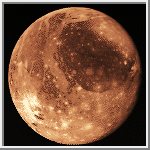
Jupiter III
Taking a new step...is what people fear most. - Dostoyevski
|
Ganymede Introduction |
|
Parent Planet |
|
Ganymede Science |
Ganymede has no known atmosphere, but recently the Hubble Space Telescope detected ozone at its surface. The amount of ozone is small as compared to Earth. It is produced as charged particles trapped in Jupiter's magnetic field rain down onto the surface of Ganymede. As the charged particles penetrate the icy surface, particles of water are disrupted leading to ozone production. This chemical process hints that Ganymede probably has a thin tenuous oxygen atmosphere like that detected on Europa.
Ganymede has had a complex geological history. It has mountains, valleys, craters and lava flows. Ganymede is mottled by both light and dark regions. It is heavily cratered especially in the dark regions implying ancient origin. The bright regions show a different kind of terrain - one which is grooved with ridges and troughs. These features form complex patterns and have a vertical relief of a few hundred meters and run for thousands of kilometers. The grooved features were apparently formed more recently than the dark cratered area perhaps by tension from global tectonic processes. The real reason is unknown; however, local crust spreading does appear to have taken place causing the crust to shear and separate.
| Ganymede Statistics | |
|---|---|
| Discovered by | Simon Marius & Galileo Galilei |
| Date of discovery | 1610 |
| Mass (kg) | 1.48e+23 |
| Mass (Earth = 1) | 2.4766e-02 |
| Equatorial radius (km) | 2,631 |
| Equatorial radius (Earth = 1) | 4.1251e-01 |
| Mean density (gm/cm^3) | 1.94 |
| Mean distance from Jupiter (km) | 1,070,000 |
| Rotational period (days) | 7.154553 |
| Orbital period (days) | 7.154553 |
| Mean orbital velocity (km/sec) | 10.88 |
| Orbital eccentricity | 0.002 |
| Orbital inclination (degrees) | 0.195 |
| Escape velocity (km/sec) | 2.74 |
| Visual geometric albedo | 0.42 |
| Magnitude (Vo) | 4.61 |
- Color Ganymede Rotation Movie.
- Ganymede Rotation Movie.
- Flight over Ganymede from Voyager data.
- Voyager/Galileo Morph Animation of Ganymede.
- Plasma Wave Sounds From Ganymede.
 Ganymede
Ganymede
This shows an entire hemisphere of Ganymede. The prominent dark region,
called Galileo Regio, is about 3,200 km in diameter. The bright spots are
relative recent impact craters. Part of the Galileo Regio may be covered
with a bright frost.
(Copyright Calvin J. Hamilton)
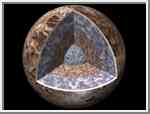 The Interior of Ganymede
The Interior of Ganymede
Voyager images were used to create a global view of
Ganymede. The cut-out reveals the interior structure of this icy moon.
This structure consists of four layers based on measurements of Ganymede's
gravity field and theoretical analyses using Ganymede's known mass, size
and density. Ganymede's surface is rich in water ice and Voyager and
Galileo images show features which are evidence of geological and tectonic
disruption of the surface in the past. As with the Earth,
these geological features reflect forces and processes deep within Ganymede's interior.
Based on geochemical and geophysical models, scientists expected
Ganymede's interior to either consist of: a) an undifferentiated mixture
of rock and ice or b) a differentiated structure with a large lunar sized
'core' of rock and possibly iron overlain by a deep layer of warm soft ice
capped by a thin cold rigid ice crust. Galileo's measurement of Ganymede's
gravity field during its first and second encounters with the huge moon
have basically confirmed the differentiated model and allowed scientists
to estimate the size of these layers more accurately. In addition the data
strongly suggest that a dense metallic core exists at the center of the
rock core. This metallic core suggests a greater degree of heating at
sometime in Ganymede's past than had been proposed before and may be the
source of Ganymede's magnetic field discovered by Galileo's space physics
experiments.
(Copyright 1999 by Calvin J. Hamilton)
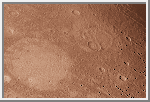 Southern Galileo Regio
Southern Galileo Regio
This image of southern Galileo Regio shows impact craters in various
stages of degradation. Almost all of the craters appear flat. The
two prominent light colored craters are almost completely erased by the
flow in the icy crust.
(Copyright Calvin J. Hamilton)
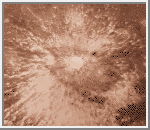 Impact Crater
Impact Crater
This mosaic of high resolution images on Ganymede shows a relative
fresh impact basin surrounded by ejecta.
(Copyright Calvin J. Hamilton)
 Craters, Light and Dark Bands
Craters, Light and Dark Bands
This image of Ganymede was taken by Voyager 1,
246,000 kilometers (158,000 miles) from the planet.
The center of the picture is at 19° south latitude
and 356° longitude, and the height of the frame represents a
distance of about 1000 kilometers (600 miles) on the surface. The smallest
features seen on this picture are about 2.5 kilometers (1.5 miles) across.
The surface displays numerous impact craters many of which have
extensive bright ray systems. The craters lacking ray systems
are probably older than those showing rays. Bright bands
traverse the surface in various directions and these bright bands
contain an intricate system of alternating linear bright and dark
lines which may represent deformation of the crusted ice layer.
These lineations are particularly evident near the top of the
picture. A bright band trending in a north-south direction in
the lower left-hand portion of the picture is offset along a
bright line. This offset is probably due to faulting. Two light
circular areas in the right upper center of the picture may be
the scars of ancient impact craters which have had their
topographic expansion erased by flowage of the crystal icy
material.
(Image Copyright Calvin J. Hamilton)
 Crescent Image of Ganymede
Crescent Image of Ganymede
This beautiful crescent image of Ganymede was taken by
Voyager 1 on March 6, 1979.
(Copyright Calvin J. Hamilton)
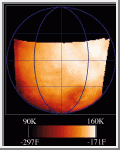 Temperature Map of Ganymede
Temperature Map of Ganymede
This map shows the temperatures for most of the surface of Ganymede
made from data taken by the Photopolarimeter/Radiometer (PPR) instrument
on June 26, 1996 as Galileo approached the sunlit side of the moon. The
color bar shows the range of temperatures of this data, with the dark
red being the coldest and white being the warmest. This is similar to
the temperature forecast maps that you see on the evening news or in
some newspapers. The difference between this map and one of Earth is
that PPR measures the temperature of the surface (the ground), instead
of air temperature. Ganymede is much colder than Earth, with these
daytime temperatures ranging across the surface from 90 to 160 Kelvin
(or -297 to -171 degrees Fahrenheit). Jupiter and its moons receive
less than 1/30th the amount of sunlight that the Earth does, and
Ganymede has essentially no atmosphere to trap heat. Ganymede's day is
just over 7 Earth days long, the same time it takes to orbit Jupiter
once.
(Courtesy NASA/JPL)
